 |
A Visual Learning Experience, Lead Guitar Made Easy
Includes Over 150 online guitar lessons - Become better today!
Welcome to Guitar Secrets
Guitar Lessons that work!
Guitar Chords
Constructing Arpeggios and Guitar Scale Relationship
The chord below is the Root 6 bar chord. It is determined by the note played on the Low E string or 6th string. It is also at times called an E type bar chord, this is because the E chord can be converted to the E bar chord. In ths guitar lesson, I will be explain this bar chord played at the fifth fret. This movable bar chord when played at the 5th fret, would be the A Major Chord. By raising the middle finger, this would now be the Am chord. Look at the Am chord below. This is played at the 5th fret index finger.
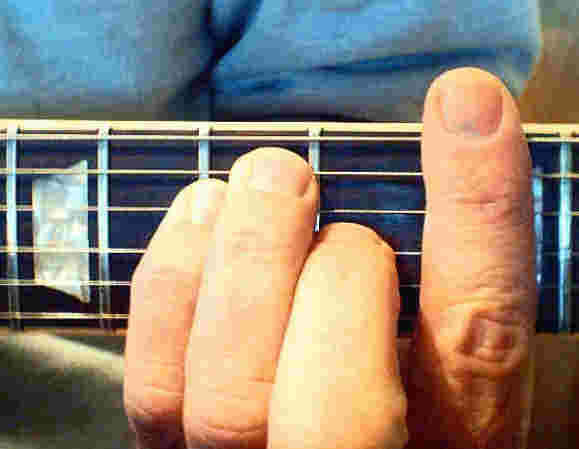
This Root 6 minor chord is also movable. By removing your middle finger, it becomes the Am chord, and is also determined by the note on the Low E string or 6th string. This chord played at the 5th fret would be the Am chord. You can play all the minor chords using this fingering pattern. The note on the Low E string determines the minor chord you are playing. If you played this fingering pattern at the 5th fret, it would be the Am chord. If you moved the pattern to the 7th fret, it would be the Bm chord. If you moved it to the 12th fret, it would be the Em chord and so on.
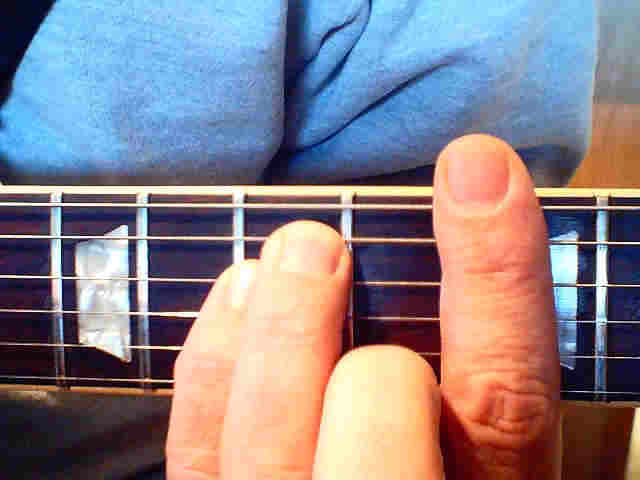
Understanding the relationship to chords over scales and arpeggios. The illustration below shows the Am pentatonic scale at the root note fret, which is the 5th fret..

The second illustration below is the Am pentatonic scale, with only the notes of the root 6 Am bar chord. The Am chord is made up of three notes. These notes are the A, C and E.

These illustrations should begin to open your eyes to the scales and the relationship to the chords that they relate to. The illustration below shows the fingering used to play the Am bar chord at the 5th fret.

Look below at the Am chord and notice how it fits over the first illustration of the Am pentatonic scale root note fret. Strum the Am chord and play the Am pentatonic scale and it should sound real nice, this is because you are playing the notes of the Am chord. Compare the fingering of the Am bar chord below to the illustration above. Notice how this chord fits over the Am pentatonic scale.
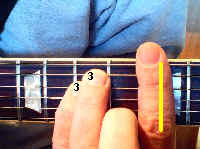
The illustration below shows the Am chord. It is played as a root 6 bar chord. The note on the six string determines the chord. Look at the note at the 5th fret Low E string. It's an A note.
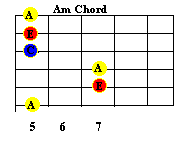
By moving the Am chord fingering pattern to the 7th fret, you would now be playing the Bm chord. Notice that both chords have the same fingering pattern. The note on the low E string determines the guitar chord. Notice that the note on the 7th fret, low E string is now the B note. This is the location you would be playing the B minor chord using the same fingering pattern.

How to build and play arpeggios. To play an arpeggio you pick each note of a chord one note at a time in a pattern. When you play a chord, you usually strum more than one of the notes of the chord together. You can learn to build melodies and construct songs when you begin to incorporate arpeggios.
The first arpeggio we will construct will be the Am chord at the root note fret or 5th fret. Look at the illustration below. This is the root 6, Am bar chord played at the 5th fret. The notes that make up the Am chord are A, C and E
Look at the illustration below and notice all the notes of the Am chord are shown. The notes of the Am chord are A, C and E.
The illustration below shows how to use the notes of the Am chord to play as an arpeggio. Start on the A note, 5th fret, Low E string. Then play each note in the numbered sequence.
The tablature is illustrated below to play the Am arpeggio at the 5th fret position. The numbers under the tablature are the suggested fingers to use.
----------------------------------5--------------
----------------------------5----------------------
-----------------------5---------------------------
-----------------7---------------------------------
-----------7---------------------------------------
-5---8--------------------------------------------
1 4 3 3 1 1 1The illustration below should be really familiar to you by now. But once again, I will explain what is going on. The outer circle shows all of the chords of the key of C major.
Each of the three sections show the notes of each chord.
Each of the chords in this section are called triads. A triad is a chord that is made up of three notes. Each of the chords in the key of C major are illustrated.
Look below and notice the C chord..
The three notes that make up the C chord are the C, E and G notes.
Notice the notes that make up the Am chord. These three notes are A, C and E. These will be the three notes we will use to play our first arpeggio. We will begin our arpeggio at the root note fret of the Am pentatonic scale and eventually learn them in other positions.
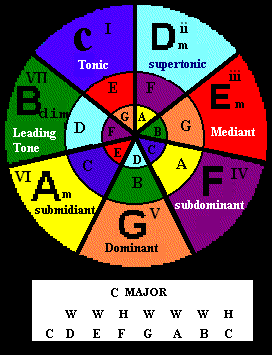
Look at the Am chord below. Notice the three notes that make up this triad. A triad is a chord with 3 notes. The three notes that make up the Am chord are A, C and E.
Look at the illustration below and notice those three notes in the Am section. Each section in the circle illustrates the notes that make up each chord.
It is possible to play every chord in the key of C major as an arpeggio over the Am pentatonic root note position. The chords we will learn in this position, will be the C, Dm, Em, F, G, Am and the B diminished chords and arpeggios. Before we do that, we must go learn the C Ionian major scale. So, go read up on this scale and we will begin to advance on our theory.
Assignments:
Study the Ionian scale
Play the Am arpeggio as much as possible.
Move the Am arpeggio finger to the Bm or 7th fret and play it as the Bm chord.
Try to play triplets using the Am arpeggio.
Use the blank chord sheets to fill in the chords for the key of C major.
Play each of the chords illustrated in the root note fret position.
Play each chord as an arpeggio, start with the root note of each chord and play to the next root of the chord. C to C for the C chord. D to D for the Dm chord and so on.
Try to figure out these chords in other locations of the fret board. Use the blank illustrations to fill in the chords.
Use a blank fretboard to fill in every note of the key of C major. Then begin to pick out each chord in different locations. By doing this, you will begin to visualize each note and it's particular position. This will really help out when playing lead.
Good Luck
Guitar Secrets
Copyright 1998 - 2018 Guitar Secrets Inc. All rights reserved |





